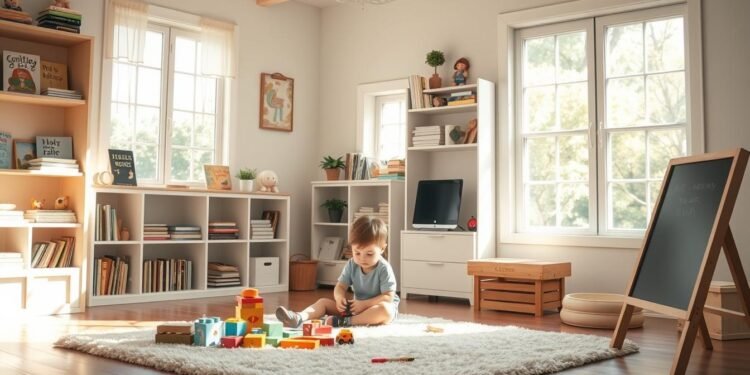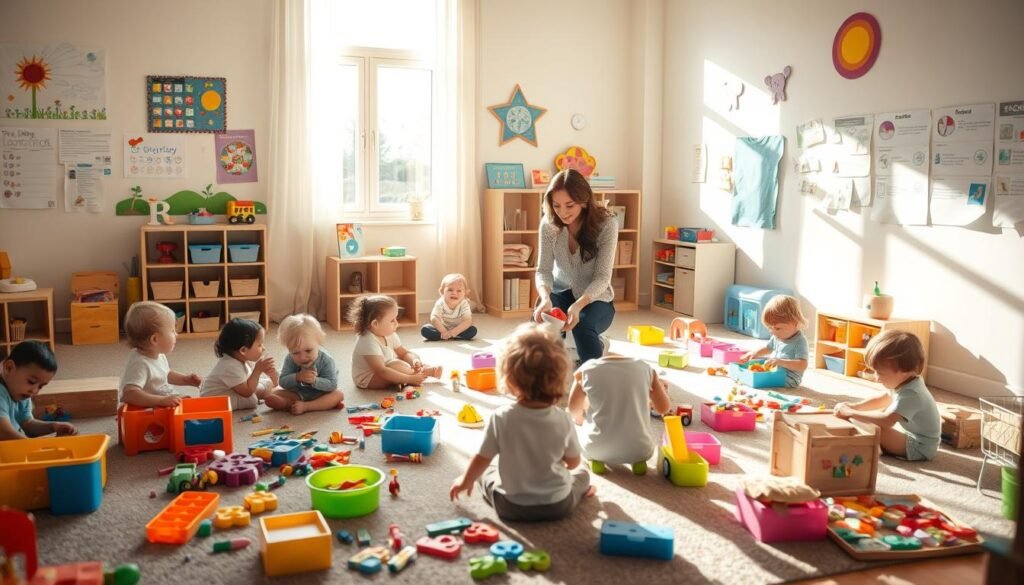Have you ever wondered if early education can be both flexible and effective? More families are exploring homeschool preschool as a way to tailor learning for their young children. This approach allows parents to create a personalized preschool curriculum that fits their child’s unique needs and pace.
Home-based learning for ages 3-5 offers numerous benefits. It fosters family bonding and lets children learn in a comfortable environment. Programs like Treehouse Schoolhouse’s 32-week literature-based curriculum and Easy Peasy’s 180-day framework provide structured yet adaptable options.
Balancing structure with play-based learning is key. Daily activities can naturally develop skills while keeping kids engaged. Common concerns, like socialization and academic readiness, can be addressed with thoughtful planning.
This article serves as a comprehensive guide for parents new to preschool homeschooling. From setting up the right environment to creating daily rhythms, you’ll find practical tips to make this journey rewarding.
Key Takeaways
- Home-based learning offers flexibility for young children.
- Customized curriculums cater to individual learning paces.
- Family bonding is a significant benefit of this approach.
- Programs like Treehouse Schoolhouse provide structured options.
- Balancing structure with play ensures organic skill development.
What is Preschool Homeschooling?
What does it mean to educate young children at home during their formative years? Homeschool preschool is a structured approach to early education designed for kids aged 2.5-5. Unlike traditional preschool models, it allows families to tailor learning to their child’s pace and interests.
This method contrasts with unschooling, which focuses on child-led exploration. It also differs from remote learning programs, which often follow a school’s curriculum. Instead, home-based education emphasizes flexibility and family involvement.
Typically, this approach spans 2-3 years before kindergarten. Core components include cognitive development, motor skills, and social-emotional learning. These areas are nurtured through play, hands-on activities, and daily routines.
Unlike formal K-12 programs, preschool homeschooling doesn’t require accreditation. Families can choose from various resources, such as Easy Peasy’s free 180-day curriculum or Treehouse Schoolhouse’s 32-week literature-based program. Both offer structured yet adaptable frameworks.
Legal requirements vary by state, so it’s essential to research local regulations. For example, some states mandate record-keeping, while others have no specific rules. A real-world example highlights this flexibility: “Our rhythms changed as we added children,” reflecting the adaptability of home education.
In summary, preschool homeschooling is a personalized, family-centered approach to early learning. It combines structure with creativity, ensuring children thrive in their preschool years while preparing for future academic success.
Why Choose Preschool Homeschooling?
Are you considering a more personalized approach to early learning for your child? Home-based education offers a range of benefits that make it an attractive option for many families. From flexible scheduling to tailored pacing, this method allows you to create a learning experience that fits your child’s unique needs.
One of the most significant advantages is the opportunity to strengthen family bonds. Shared learning experiences, like reading together or exploring nature, foster deeper connections. These moments not only enhance education but also build lasting memories.
Cost savings are another compelling reason. Traditional preschool tuition can be expensive, but home education eliminates those fees. Families can invest in resources like books, art supplies, or educational tools instead.
For those integrating faith into their daily lives, home-based learning provides a natural platform. Activities like prayer, Bible stories, and moral lessons can be seamlessly woven into the curriculum. This approach nurtures both academic and spiritual growth.
Children with special needs also benefit from this model. Parents can adapt teaching methods to suit their child’s abilities, ensuring they thrive. Research shows that homeschooled children often develop strong social skills, debunking the myth that they lack socialization opportunities.
Multi-age learning is another perk. Older siblings can assist younger ones, creating a collaborative environment. As one parent shared, “Our days are both full and calm,” highlighting the balance this approach offers.
Expert Amy Sloan emphasizes, “The best tool is changing perspective.” By focusing on the child’s needs and interests, families can create a fulfilling educational journey. Whether it’s through play, exploration, or structured lessons, home-based learning empowers families to shape their children’s early years in meaningful ways.
Setting Up Your Homeschool Preschool Environment
Creating the right environment for early learning at home can make all the difference. A well-designed space encourages focus, creativity, and independence. Whether you’re working with a dedicated room or a multi-use area, thoughtful planning ensures a functional and inspiring setup.
Creating a Learning Space
Start by choosing an area in your house that’s free from distractions. Child-sized tables and chairs make the space more inviting. Accessible storage, like low shelves or bins, helps kids easily find and put away materials.
DIY learning stations can add variety. A reading nook with cozy pillows, an art corner with supplies, and a sensory bin for hands-on exploration are great additions. Rotating materials keeps the space fresh and engaging.
Essential Materials and Resources
Invest in tools that support learning and development. Montessori trays, rhythm sticks, and felt boards are excellent for hands-on activities. Playdough and activity trays are perfect for enhancing fine motor skills.
Technology can also play a role. Tablets with educational apps offer interactive learning opportunities. For budget-friendly options, repurpose household items or create DIY resources.
Safety is a priority. Ensure materials are age-appropriate and the space is childproofed. A checklist for emergency preparedness adds an extra layer of security.
By thoughtfully setting up your learning environment, you create a space where children can thrive. As one parent shared, “Our sensory space with activity trays has become a favorite spot for exploration and growth.”
Developing a Preschool Homeschool Curriculum
How can you create a curriculum that sparks curiosity and growth in young learners? A well-rounded plan focuses on key areas like literacy, math, and motor skills. These elements work together to build a strong foundation for future learning.
Literacy and Language Development
Early literacy skills are crucial for communication and comprehension. Start with phonemic awareness through nursery rhymes and songs. These activities make learning sounds fun and engaging.
Nature-based activities, like identifying letters on leaves or rocks, help with letter recognition. Living books, which tell stories with rich language, are excellent for vocabulary building. Aim for 15 minutes of focused literacy practice daily to keep it manageable.
Math Skills for Preschoolers
Math doesn’t have to be intimidating. Use everyday situations, like counting items at the grocery store, to teach basic concepts. The Greater-Than-Gator method is a playful way to introduce inequalities.
Treehouse’s multi-sensory approach combines music and movement with math. Easy Peasy’s offline workbooks offer additional practice. These resources make learning math interactive and enjoyable.
Fine and Gross Motor Skills
Developing motor skills is essential for physical and cognitive growth. Scissor progression exercises improve fine motor control. Activities like jumping, running, and balancing strengthen gross motor skills.
Treehouse’s music and movement components add a creative twist. Sensory bins and playdough are also great tools for hands-on learning. These activities keep kids active while enhancing their coordination.
Daily Routine and Rhythm for Preschool Homeschooling
How can a daily routine shape your child’s learning experience at home? Establishing a consistent rhythm helps young learners feel secure and focused. A well-planned day balances structured activities with free play, ensuring both growth and enjoyment.
Sample Daily Schedule
Start the day with parent prep time at 7:00 AM. This allows you to set the tone for the day. By 9:45 AM, engage in structured activities like reading or math. These sessions should be short and interactive to hold their attention.
After lunch, incorporate a mandatory quiet time at 1:00 PM. This break helps children recharge. Use transition strategies, like songs or visual cards, to move smoothly between activities. Flexibility is key, so include buffer zones and plan B options for unexpected changes.
Importance of Flexibility
While structure is important, adaptability ensures success. Weather-dependent alternatives, like indoor crafts on rainy days, keep the rhythm intact. Meal planning integration saves time and reduces stress. Weekly variations, such as Field Trip Fridays, add excitement to the routine.
Bedtime routines also impact the next day. A consistent wind-down helps children sleep better and wake up ready to learn. Tools like digital planners or loop scheduling for chores streamline daily tasks, making the day run smoothly.
By balancing structure with flexibility, you create a nurturing environment where children thrive. As one parent shared, “Our routine keeps us grounded, but our adaptability keeps us moving forward.”
Incorporating Play-Based Learning
What role does play have in shaping a child’s early learning journey? Play is more than just fun—it’s a powerful tool for development. Through play, children explore, experiment, and build essential skills in a natural and engaging way.
Learning Through Play
Balancing structured and unstructured play is key. Structured activities, like Montessori practical life tasks, teach focus and independence. Unstructured play, such as building with blocks, encourages creativity and problem-solving.
Dramatic play stations, like a pretend kitchen or doctor’s office, help develop social skills. Rotating toys keeps the experience fresh and exciting. Documenting these moments can show progress and spark new ideas.
Outdoor and Sensory Play
Outdoor play offers endless opportunities for exploration. Nature scavenger hunts teach observation skills, while mud pie-making integrates math concepts like measurement and counting. Rainy days can still be active with indoor obstacle courses.
Sensory play is equally important. Simple sensory bins with rice, beans, or water beads enhance fine motor skills. Adding tools like scoops or tweezers makes it even more engaging. Always follow safety protocols for outdoor and sensory activities.
By incorporating play into daily routines, you create a rich learning environment. Whether it’s a backyard adventure or a sensory bin activity, play-based learning fosters growth in a joyful and meaningful way.
Using Technology and Online Resources
How can technology enhance your child’s learning experience at home? With the right tools, digital resources can make education engaging and effective. From apps to virtual field trips, there are countless ways to integrate online learning into your routine.
Recommended Apps and Websites
Easy Peasy’s All-in-One system is a free platform that offers structured lessons for young learners. It’s user-friendly and covers a wide range of subjects. Treehouse’s Morning Time Bundle includes digital rhythm cards, perfect for adding creativity to your daily schedule.
When evaluating educational apps, consider factors like ease of use, age-appropriateness, and learning outcomes. Look for apps that encourage interaction and critical thinking. Virtual field trips are another great way to explore the world without leaving home.
Balancing Screen Time
While technology is a valuable tool, it’s important to balance screen time with other activities. Set clear limits and use parental controls to manage usage. Incorporate tech-free alternatives, like hands-on projects or outdoor play, to develop critical skills.
Blended learning, which combines digital and traditional methods, can be highly effective. For example, pair video lessons with physical activities to reinforce concepts. Regularly assess your child’s progress and adjust the approach as needed.
By thoughtfully integrating technology and maintaining a healthy balance, you can create a dynamic and enriching learning environment for your child.
Building a Support Network
How can you ensure a smooth and successful home-based learning experience for your child? A strong support network is essential. Connecting with others who share your journey can provide encouragement, resources, and practical advice.
Local and online communities offer unique benefits. Local groups often host in-person events, fostering friendships and hands-on learning. Online forums provide a broader perspective and access to global resources. Both options can help you feel less isolated and more empowered.
Joining Homeschool Groups
Co-op programs are a great way to collaborate with other families. These groups often share teaching responsibilities, allowing parents to focus on their strengths. Special needs resource networks are also available, offering tailored advice and support.
Mentor matching strategies can connect you with experienced homeschoolers. Their insights can help you navigate challenges and celebrate successes. Professional development opportunities, like workshops and webinars, keep you updated on the latest trends and techniques.
Seeking Expert Advice
Experts can provide valuable guidance on curriculum choices and teaching methods. Crisis support systems ensure you have help during tough times. Event planning templates simplify organizing group activities, making it easier to stay involved.
Boundary-setting techniques help maintain a healthy balance between teaching and personal life. Multi-generational learning models encourage family members of all ages to participate. Tracking alumni success stories can inspire and motivate your journey.
By building a robust support network, you create a foundation for long-term success. Whether through local groups, online friends, or expert advice, these connections make the work of homeschooling more manageable and rewarding.
Conclusion
Building a strong foundation for your child’s education starts with thoughtful planning and flexibility. By focusing on core principles like play, routine, and adaptability, you can create a nurturing environment where learning feels natural and enjoyable.
Remember, the journey is as important as the destination. Embrace an open-hands philosophy, allowing room for growth and unexpected discoveries. Start small with actionable tips, such as setting up a daily rhythm or incorporating play-based activities. Celebrate milestones to keep motivation high.
As one parent shared, “Days are both full and calm,” highlighting the balance this approach offers. With ongoing support and a growth mindset, you can confidently guide your children through this rewarding experience. Explore additional resources and connect with communities to enrich your journey further.
FAQ
What is preschool homeschooling?
Preschool homeschooling is the practice of educating young children at home during their early years, focusing on foundational skills like literacy, math, and motor development through structured and play-based activities.
Why should I consider homeschooling for my preschooler?
Homeschooling allows for a personalized learning experience, fostering a strong parent-child relationship while tailoring lessons to your child’s unique pace and interests.
How do I create a learning space at home?
Designate a quiet, organized area with essential materials like books, art supplies, and educational toys to encourage focus and creativity during learning time.
What materials are essential for a homeschool preschool?
Key resources include alphabet books, counting tools, art supplies, puzzles, and sensory play items to support literacy, math, and motor skill development.
How can I develop a balanced curriculum for my preschooler?
Focus on literacy, math, and motor skills through daily activities like reading stories, counting games, and arts and crafts to create a well-rounded learning experience.
What does a typical daily schedule look like?
A sample day might include morning reading, math games, outdoor play, and creative arts, with flexibility to adapt to your child’s needs and interests.
How important is play in preschool learning?
Play is crucial for developing social, emotional, and cognitive skills. Incorporate sensory and outdoor activities to make learning engaging and fun.
Can technology be part of preschool homeschooling?
Yes, educational apps and websites can supplement learning, but it’s important to balance screen time with hands-on activities and play.
How can I connect with other homeschooling families?
Join local or online homeschool groups to share resources, ideas, and support with other parents on the same journey.
Where can I find expert advice for homeschooling?
Seek guidance from experienced homeschoolers, educational consultants, or online communities to address specific challenges and questions.






